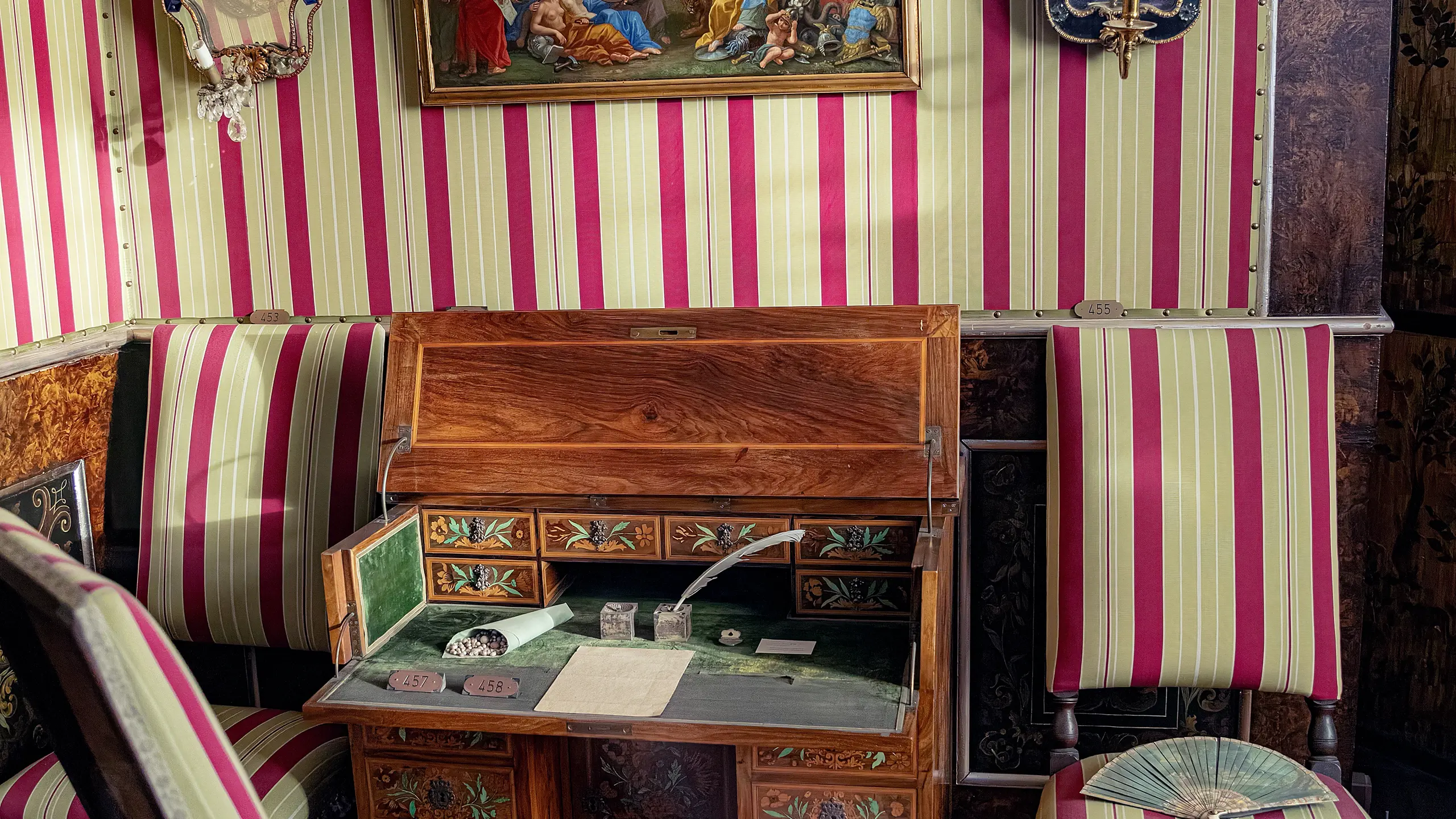The Garden Room (room 4A)
Originally, this was Christian IV's bathroom, but under Frederik IV, the room was converted into a cabinet for Frederik IV and his Queen Louise. The room was named the Garden Room because from here, one could sit and enjoy the view of the garden.

From bathroom to garden room
The Garden Room was originally Christian IV's bathroom, with direct access to his toilet (the 'Secret') and his bedroom. In 1705-1706, it was converted into a small, private chamber for Frederik IV and Queen Louise. This transformation occurred when they converted what is now called 'the Dark Room' into their shared bedroom.
The current furnishings and objects in the Garden Room tell the story of Frederik IV and Queen Louise, who were the last royal couple to use Rosenborg as a residence.
The stucco ceiling in the Garden Room was crafted by Frederik Ehbisch, and the ceiling painting, which celebrates the power of wine, was created by Bénoit le Coffre. The inlaid floor of oak and walnut, as well as the marbled and painted panels, date back to 1707.
At the request of Christian VI, the south-facing window was replaced by a double door in 1745, providing direct access to the private garden to the west via a staircase.
previous room <- | -> next room
Objects in the room
If you are at the museum, you can admire the fascinating objects in the room and read more about them below.
The descriptions are brief and generally do not include images. They are intended as an added resource if you would like more detailed information about an item, such as who made it, its origin and its meaning.
-
450Mirror, Bohemia 1720-30.
-
451Queen Louise painted as Crown Princess, half-length portrait by Jacob d’Agar 1695-99.
-
452Fire-screen, probably embroidered by Frederik IV’s mother, Dowager Queen Charlotte Amalie.
-
453Mirror with candlesticks, Bohemia c.1700.
-
454The Apotheosis of Art. Painting by Hendrick Krock 1700.
-
455Mirror with candlesticks, Nuremberg c.1690.
-
456Four chairs, Copenhagen c.1690.
-
457Writing desk, walnut, inlaid with flowers of bone and mother-of-pearl. On the lid, weapon-trophies and a crowned “C” for Prince Carl or Crown Prince Christian (VI)? Copenhagen, 1710-20?
-
458Paper cone with Norwegian freshwater pearls, to which the Danish Queen had sole and exclusive right.
-
459Ivory fan with lacquer painting, said to have been bought by Frederik IV in Italy and presented to the Queen.
-
460Five-part folding screen of plaited straw with rural and chivalrous scenes. Germany c.1675.
-
461Bacchus and Ariadne. Painting by Hendrick Krock, 1713.
-
462Two cabinets with inlaid mosaics of semi-precious stones. The mosaics were brought back from Florence by Frederik IV in 1709, while the cupboards themselves are attributed to Court Cabinetmaker Claus Harder 1710-20. The table feet were renewed c.1740. Belonged to Frederik IV’s and Queen Louise’s only daughter, Princess Charlotte Amalie.
-
463Set of vases with laque brillante, made by Queen Louise as presents for Frederik IV.
-
464Tilting table with inlays of flowers, attributed to Claus Harder c.1710.
-
465Two sets of cups and saucers with Frederik IV’s monogram, from c.1700. The cups are Chinese, the saucers Japanese.
-
466Two tea-pitchers of Kang’shi-porcelæn, China 1700-25.
-
467Jupiter and Io. Painting by Hendrick Krock, 1713.
-
468Clock with hour-stroke, clad in tortoiseshell and silver, drawer containing an apothecary. The dial has the mark: Georg Braun. Silver work signed J.A. Thelott. Apothecary marked Elias Adam, Augsburg 1708-13. Belonged to Princess Charlotte Amalie.